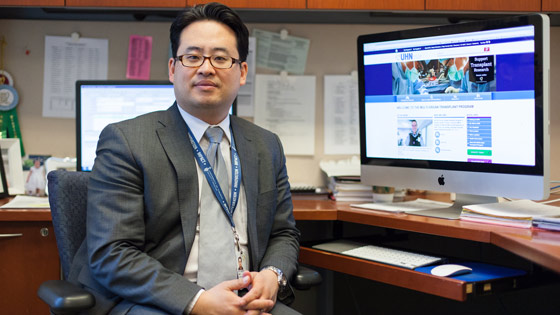
Dr. Joseph Kim, co-director, Kidney Transplant Program, UHN. Last year the program performed 80 transplants from living donors, and 80 from deceased donors. (Photo: UHN)
In a different life, Rosemarie Dwyer was a nurse, loved by patients and colleagues alike at Sunnybrook Health Science Centre where she worked for over 12 years. That life changed drastically in 2002 when she was diagnosed with lupus, an autoimmune disorder that causes the body to attack itself, destroying organs and tissue.
"Staying positive was a struggle because I had watched my aunt die of the same disease," said Dwyer. "Three years later my joints began to hurt and my limbs swelled. The lupus started attacking my kidneys and my condition got worse."
Total kidney failure
The turning point was in 2008, when Dwyer's kidneys failed. She joined the kidney transplant waiting list at Toronto General Hospital (TGH) and started dialysis. Three times a week she went to the hospital where a machine removed waste and excess water from her blood. This process can take over four hours per visit.
Home hemodialysis program
At any point in time, there are more than 1,000 patients waiting for a kidney transplant in Ontario. About two per cent of these people die on the waiting list for a kidney every year.
Today, as part of the TGH intensive home hemodialysis program, Dwyer has a dialysis machine at home. But this is not a long-term solution; the veins in her arms are damaged from years of dialysis, forcing her to connect to the machine using veins near her groin – which is painful and has risks.
"I can't get comfortable at night when the machine is on, but there is no other choice," said Dwyer. "I have faith that I will find a donor, and be able to return to nursing one day. I'm also very grateful to the doctors and nurses at Toronto General and Toronto Western. They continue to provide the best care for me during hospitalization and monthly check up."
Finding a donor
Kidney donations come from two sources: deceased donors and living donors. Anyone can become an organ donor by
registering online with Service Ontario, or at any Service Ontario location.
"A living donor kidney transplant is preferable since the date of the surgery can be planned in advance and the kidneys from living donors tend to last longer than kidneys from deceased donors," said Dr. Joseph Kim, co-director of the TGH Kidney Transplant Program. "Moreover, patients receiving a living donor kidney can avoid the long wait for a deceased donor kidney."
Living donors have the same long-term survival rates, quality of life and general health as people who don't donate. Following surgery, the donor's remaining kidney enlarges to compensate for the removed kidney, and within a year functions at 65 to 70 per cent of the original two kidneys.
Staying hopeful
Since working in health care, Dwyer has always been an advocate for organ donation. She shared her beliefs with her family and friends when she wrote them an open letter explaining her medical journey. She plans to continue educating people about the amazing work at Toronto General Hospital and Trillium Gift of Life, despite her exhaustion from nightly dialysis.
"I'd like to start a blog to tell people how they can become organ donors," said Dwyer. "Helping others in my position understand dialysis isn't the end of the road gives me a sense of purpose. There's still more you can do, there's still hope."
Related Links
- To find out more about becoming a living kidney donor click
here or call the TGH Living Kidney Donor Program at 416-340-4800 ext: 4848.
-
To learn more about registering as an organ donor visit
beadonor.ca.
